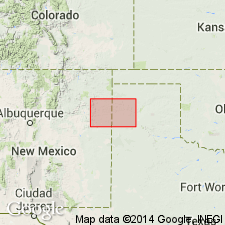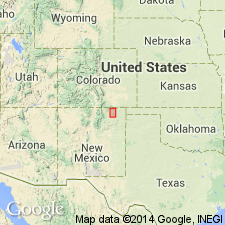
- Usage in publication:
-
- Raton Basalt
- Modifications:
-
- Overview
- Dominant lithology:
-
- Basalt
- AAPG geologic province:
-
- Sierra Grande uplift
Summary:
Is Pliocene formation mapped in Harding Co, NM (Sierra Grande uplift). Southward continuation of basalt mapped as "undifferentiated Clayton Basalt" in southwestern Union Co, NM. Medium-grained olivine basalt, contains yellow-brown olivine phenocrysts 2 to 3 mm in diameter, stubby columnar jointing prominent.
Source: GNU records (USGS DDS-6; Denver GNULEX).

- Usage in publication:
-
- Raton Basalt*
- Modifications:
-
- Geochronologic dating
- Overview
- AAPG geologic province:
-
- Las Vegas-Raton basin
Summary:
Is oldest (of three) basaltic to latiandesitic effusive rock unit mapped in western part of Raton-Clayton volcanic field, Colfax Co, NM in Las Vegas-Raton basin. Caps highest and longest mesas in area. Includes many sheets of lava; vents are generally no longer marked by cinder cones. Analyzed specimens are olivine basalts, alkali basalts, a few trachybasalts, and latibasalts. Rocks are medium to dark gray or black, very hard, and in part vesicular; some have silvery sheen on fresh break, apparently owing to fine diktytaxitic texture; are visibly porphyritic (typically olivine is the only phenocryst), but some flows have phenocrysts or xenocrysts of other minerals; altered olivine phenocrysts appear as red or brown specks. Petrography and petrochemistry described. K-Ar ages range from 3.5 to 4.0 m.y. Age is Pliocene.
Source: GNU records (USGS DDS-6; Denver GNULEX).
For more information, please contact Nancy Stamm, Geologic Names Committee Secretary.
Asterisk (*) indicates published by U.S. Geological Survey authors.
"No current usage" (†) implies that a name has been abandoned or has fallen into disuse. Former usage and, if known, replacement name given in parentheses ( ).
Slash (/) indicates name conflicts with nomenclatural guidelines (CSN, 1933; ACSN, 1961, 1970; NACSN, 1983, 2005, 2021). May be explained within brackets ([ ]).

